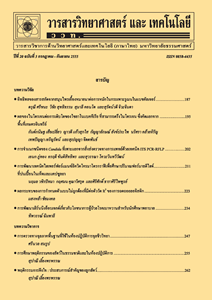การประเมินความสัมพันธ์ทางพันธุกรรมในกล้วยไม้สกุลหวายกลุ่มเอื้องสายด้วยเครื่องหมายแฮตอาร์เอพีดี
Main Article Content
Abstract
บทคัดย่อ
เอื้องสายเป็นกล้วยไม้สกุลหวายกลุ่มหนึ่งที่นิยมปลูกเลี้ยงตามอาคารบ้านเรือนเช่นเดียวกับกล้วยไม้ชนิดอื่น ซึ่งมีการปรับปรุงพันธุ์ด้วยการผสมพันธุ์และขยายพันธุ์ด้วยการเพาะเลี้ยงเนื้อเยื่อ จึงทำให้มีความหลากหลายทางพันธุกรรมสูง ดังนั้นการจำแนกชนิดด้วยลักษณะสัณฐานอาจมีความยุ่งยากและเกิดความสับสนได้ง่าย งานวิจัยนี้จึงนำเทคนิคแฮตอาร์เอพีดีมาตรวจสอบพันธุ์กล้วยไม้สกุลหวาย 15 พันธุ์ ซึ่งเป็นกล้วยไม้กลุ่มเอื้องสาย 14 พันธุ์ โดยใช้ไพรเมอร์แบบสุ่ม 72 ชนิด พบว่าไพรเมอร์ 51 ชนิด สามารถเพิ่มปริมาณดีเอ็นเอได้ เมื่อคัดเลือกไพรเมอร์ 24 ชนิด ที่ให้ลายพิมพ์ดีเอ็นเออย่างชัดเจนมาตรวจสอบกับดีเอ็นเอของกล้วยไม้สกุลหวายแต่ละพันธุ์ พบว่าสามารถแยกความแตกต่างระหว่างพันธุ์ได้ด้วยแถบดีเอ็นเอที่จำเพาะกับพันธุ์ นอกจากนั้นยังพบไพรเมอร์ 20 ชนิด ที่สามารถจำแนกกล้วยไม้สกุลหวายทั้ง 15 พันธุ์ ได้โดยใช้ไพรเมอร์เพียงชนิดเดียว เมื่อวิเคราะห์ความสัมพันธ์ทางพันธุกรรมพบว่ามีค่าสัมประสิทธิ์ความเหมือนอยู่ระหว่าง 0.27 ถึง 0.71 โดยผลการวิจัยครั้งนี้แสดงให้เห็นว่าเครื่องหมายแฮตอาร์เอพีดีสามารถระบุชนิดของกล้วยไม้สกุลหวายกลุ่มเอื้องสาย ซึ่งใช้วางแผนการผสมพันธุ์เพื่อพัฒนาพันธุ์ใหม่ ๆ ได้
คำสำคัญ : สกุลหวาย; เอื้องสาย; ความสัมพันธ์ทางพันธุกรรม; เครื่องหมายดีเอ็นเอ; แฮตอาร์เอพีดี
Abstract
Ueang Sai is a group of genus Dendrobium which the popular orchids of growers by dwellings as well as other species. The improved varieties by breeding and propagation using tissue culture to generated a high genetic diversity. Therefore, identification base on morphology may be cumbersome and confusing easily. High annealing temperature-random amplified polymorphic DNA (HAT-RAPD) technique was used to identify 15 species (varieties) of Dendrobium, which 14 species were the members of Ueang Sai group. The total 72 random primers were screened and 51 primers could be used for DNA amplification. Twenty-nine primers were selected and used analyze each DNA species of Ueang Sai group. The result showed differences among 15 species with specific DNA bands. In addition, 20 of 24 random primers were able to identify each species even though using as only one primer. A dendrogram based on polymorphic bands showed genetic similarities among Ueang Sai group with similarity coefficients ranging 0.27-0.71. Finally, these results indicate that the HAT-RAPD markers capable to specify Ueang Sai group, which used to planning in the breeding program.
Keywords: Dendrobium; Ueang Sai; genetic relationship; DNA marker; HAT-RAPD

